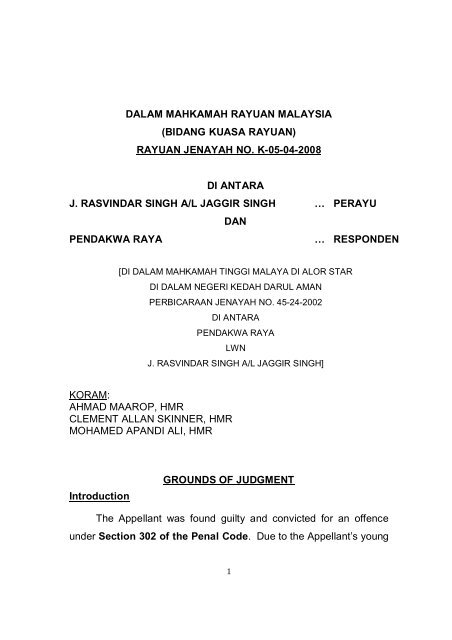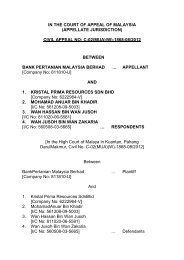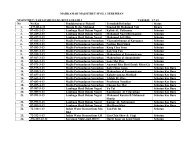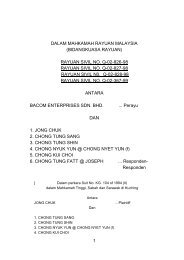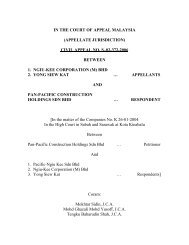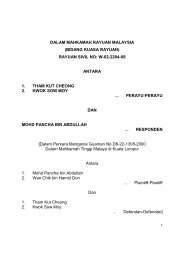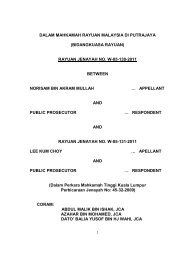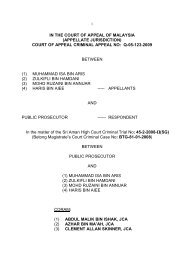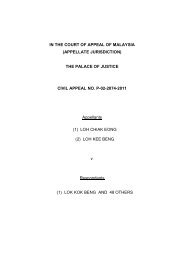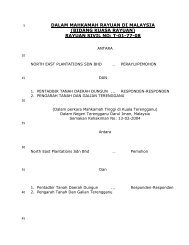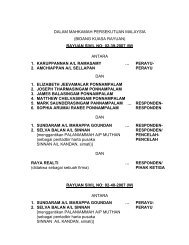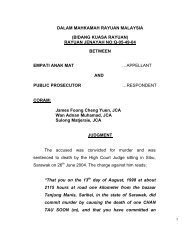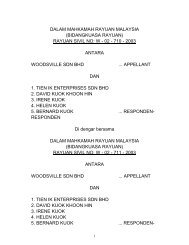rayuan jenayah no. k-05-04-2008 di antara j. rasvindar singh a/l ...
rayuan jenayah no. k-05-04-2008 di antara j. rasvindar singh a/l ...
rayuan jenayah no. k-05-04-2008 di antara j. rasvindar singh a/l ...
You also want an ePaper? Increase the reach of your titles
YUMPU automatically turns print PDFs into web optimized ePapers that Google loves.
DALAM MAHKAMAH RAYUAN MALAYSIA<br />
(BIDANG KUASA RAYUAN)<br />
RAYUAN JENAYAH NO. K-<strong>05</strong>-<strong>04</strong>-<strong>2008</strong><br />
DI ANTARA<br />
J. RASVINDAR SINGH A/L JAGGIR SINGH … PERAYU<br />
DAN<br />
PENDAKWA RAYA … RESPONDEN<br />
[DI DALAM MAHKAMAH TINGGI MALAYA DI ALOR STAR<br />
DI DALAM NEGERI KEDAH DARUL AMAN<br />
PERBICARAAN JENAYAH NO. 45-24-2002<br />
DI ANTARA<br />
PENDAKWA RAYA<br />
LWN<br />
J. RASVINDAR SINGH A/L JAGGIR SINGH]<br />
KORAM:<br />
AHMAD MAAROP, HMR<br />
CLEMENT ALLAN SKINNER, HMR<br />
MOHAMED APANDI ALI, HMR<br />
Introduction<br />
GROUNDS OF JUDGMENT<br />
The Appellant was found guilty and convicted for an offence<br />
under Section 302 of the Penal Code. Due to the Appellant’s young<br />
1
age, the Appellant was sentenced to be detained in prison at the<br />
pleasure of the Ruler, under Section 97(2) of the Child Act 2001.<br />
At the commencement of the trial, the Appellant was charged<br />
with a<strong>no</strong>ther co-accused, Kartik a/l Thavasi Ka<strong>no</strong>o and the charge<br />
reads as follows:-<br />
“Bahawa kamu bersama-sama pada 3.3.2002 jam lebih<br />
kurang 11.00 malam, <strong>di</strong> tepi jalan, berdekatan bengkel JKR, Jalan<br />
Lencongan Timur Aman Jaya <strong>di</strong> Daerah Kuala Muda, <strong>di</strong> dalam<br />
Negeri Kedah, telah dengan sengaja mendatangkan kematian<br />
kepada Saravanan a/l Jay Remey KP. 83<strong>05</strong>09-02-5933. Oleh yang<br />
demikian telah melakukan kesalahan yang boleh <strong>di</strong>hukum <strong>di</strong> bawah<br />
seksyen 302 Kanun Keseksaan <strong>di</strong>baca bersama seksyen 34 Kanun<br />
Keseksaan.”<br />
At the end of the case for the prosecution, the trial Court<br />
acquitted and <strong>di</strong>scharged the co-accused and the Appellant’s defence<br />
was called on an amended charge, which reads as follows:-<br />
“Bahawa kamu pada 3.3.2002 jam lebih kurang 11.00<br />
malam, <strong>di</strong> tepi jalan berdekatan bengkel JKR, Jalan Lencongan<br />
Timur Aman Jaya, dalam Daerah Kuala Muda, dalam Negeri Kedah<br />
Darul Aman telah melakukan kesalahan membunuh ke atas<br />
Saravanan a/l Jay Remey (KP. 83<strong>05</strong>09-02-5933) dan oleh itu kamu<br />
telah melakukan kesalahan <strong>di</strong> bawah seksyen 302 Kanun<br />
Keseksaan.”<br />
2
Factual matrix of the case<br />
The facts of the case are well set out in the Judgment of the<br />
learned trial Judge. Thus in this judgment, we need <strong>no</strong>t repeat the<br />
facts, but shall only refer to the basic relevant facts and events as<br />
found by the learned trial Judge.<br />
Accor<strong>di</strong>ng to the pathologist, SP7, the cause of death was due<br />
to “head injury due to blunt trauma”. This fact was un<strong>di</strong>sputed.<br />
On the night of the incident, the deceased, Saravanan was a<br />
rider of a motorcycle with SP9, Kesavan as his pillion rider. The<br />
Appellant was the pillion rider of a motorcycle ridden by SP8,<br />
Ganesan. The co-accused, Kartik was the pillion rider of a<strong>no</strong>ther<br />
motorcycle ridden by SP6, Sugumar.<br />
Accor<strong>di</strong>ng to SP6, Sugumar, he and SP8, Ganesan, with their<br />
respective pillion riders chased after the motorcycle ridden by the<br />
deceased. SP6 also gave evidence that both the Appellant and the<br />
co-accused, Kartik as pillion riders had a long stick each. On the<br />
instructions of Kartik, the deceased motorcycle was blocked by the<br />
motorcycle ridden by SP6. SP6 further narrated that, Kartik jumped<br />
from the motorcycle and assaulted the pillion rider (SP9) and at that<br />
time the deceased fell from his motorcycle. Both, Kartik and the<br />
Appellant then assaulted the deceased who was lying on the ground.<br />
Accor<strong>di</strong>ng to SP9, Kasavan, the assault incident took place within a<br />
3
short span of time of between 3 to 4 minutes only and there were 6<br />
persons at the material time.<br />
Those are the relevant facts but nevertheless <strong>di</strong>sputed.<br />
Fin<strong>di</strong>ngs by the High Court<br />
The learned trial Judge, at the end of the prosecution’s case<br />
made a fin<strong>di</strong>ng that a prima facie case has been proved against the<br />
Appellant alone. The fin<strong>di</strong>ngs by the learned trial Judge as to the act<br />
of the Appellant that constituted the commission of the alleged<br />
offence were based on:-<br />
(i) the acceptance of the evidence of SP6, Sugumar; SP8,<br />
Ganesan and SP9, Kasavan;<br />
(ii) the evidence of information lea<strong>di</strong>ng to <strong>di</strong>scovery of a<br />
piece of wood given by the Appellant after his arrest by<br />
the police; and<br />
(iii) the evidence of SP9, Kasavan, which exculpated the co-<br />
accused, Kartik of the offence.<br />
The Appellant’s contentions<br />
The Appellant’s Counsel put forward 3 basic contentions:<br />
(i) that there was <strong>no</strong> maximum evaluation of the prosecution<br />
evidence as mandated under Section 180 of the<br />
Criminal Procedure Code and as reaffirmed by the case<br />
4
law of Looi Kow Chai & A<strong>no</strong>r v. PP [2003] 2 MLJ 65<br />
and as approved by the Federal Court in Magendran<br />
Mohan v. PP [2011) 1 CLJ 8<strong>05</strong>;<br />
(ii) that there was a failure to consider that the witnesses,<br />
SP6 and SP8 as accomplices, are in the circumstances,<br />
<strong>no</strong>t cre<strong>di</strong>ble or reliable;<br />
(iii) that the information lea<strong>di</strong>ng to <strong>di</strong>scovery given by the<br />
Appellant was wrongly admitted; and<br />
(iv) that the defence story has <strong>no</strong>t been properly evaluated,<br />
namely <strong>no</strong>t tested with the cautioned statement of SP6,<br />
Sugumar, which was tendered by the defence as exhibit<br />
D28.<br />
Our analysis and fin<strong>di</strong>ngs<br />
As the contentions by the Appellant in (i) and (ii) above are<br />
inter-related, we shall deal with them together.<br />
It is <strong>no</strong>t in <strong>di</strong>spute that SP6 and SP8 were originally jointly<br />
charged with the Appellant for the alleged offence. This can be seen<br />
at the initial charging at the Magistrate’s Court at Sungai Petani. This<br />
was on 18/3/2002. When the trial commenced on 2/9/2002, both SP6<br />
and SP8 became prosecution witnesses.<br />
From the events prior to and lea<strong>di</strong>ng to the alleged assault on<br />
the deceased, it was also un<strong>di</strong>sputed that both SP6 and SP8 were<br />
5
accomplices. In fact the learned trial Judge <strong>di</strong>d in<strong>di</strong>cate that he<br />
accepted the defence submission that SP6 and SP8 were<br />
accomplices. It is our judgment that having accepted that fact, the<br />
trial Judge ought to have taken the next step of considering whether<br />
the witnesses are reliable or otherwise. Having been satisfied as to<br />
the issue of reliability then only the subsequent step of evaluating<br />
whether there is a need of corroborative evidence can be taken. The<br />
law on this has been succinctly put by Gunn Chit Tuan J. in T.N.<br />
Nathan v. PP [1978] 1 MLJ 134 @ pg. 137, which reads:-<br />
“It was common ground that he was an accomplice and that there<br />
was <strong>no</strong> corroboration of his testimony. Even if there was<br />
corroboration, the evidence of the accomplice in this case could <strong>no</strong>t<br />
be corroborated because he was <strong>no</strong>t a cre<strong>di</strong>ble or reliable witness.<br />
Thus it was held by the Supreme Court of In<strong>di</strong>a in the case of<br />
Sarwan Singh v. State of Punjab A.I.R 1957 S.C.637, 641 that –<br />
“… before the court reaches the stage of considering the<br />
question of corroboration and its adequacy or otherwise,<br />
the first initial and essential question to consider is whether<br />
even as an accomplice the approver is a reliable witness.<br />
If the answer to this question is against the approver then<br />
there is an end of the matter, and <strong>no</strong> question as to<br />
whether his evidence is corroborated or <strong>no</strong>t falls to be<br />
considered.<br />
In other words, the appreciation of an approver’s evidence<br />
has to satisfy a double test. His evidence must show that<br />
he is a reliable witness and that is a test which is common<br />
to all witnesses. If this test is satisfied the second test<br />
which still remains to be applied is that the approver’s<br />
evidence must receive sufficient corroboration. This test is<br />
6
special to the cases of weak or tainted evidence like that of<br />
the approver.”<br />
Lord Hailsham has expresses a similar opinion in the English<br />
House of Lord’s case of Director of Public Prosecutions v.<br />
Kilbourne [1973] 1 All E.R. 440, 452 when he said as follows:-<br />
“Corroboration is only required or afforded if the witness<br />
requiring corroboration or giving it is otherwise cre<strong>di</strong>ble. If<br />
his evidence is <strong>no</strong>t cre<strong>di</strong>ble, a witness’s testimony should<br />
be rejected and the accused acquitted, even if there could<br />
be found evidence capable of being corroboration in other<br />
testimony. Corroboration can only be afforded to or by a<br />
witness who is otherwise to be believed. If a witness’s<br />
testimony falls of its own inanition the question of his<br />
nee<strong>di</strong>ng, or being capable of giving, corroboration does <strong>no</strong>t<br />
arise.”<br />
In our case, as the accomplice could <strong>no</strong>t be considered a<br />
reliable or cre<strong>di</strong>ble witness, the question of corroboration therefore<br />
<strong>di</strong>d <strong>no</strong>t arise.”<br />
The learned trial Judge held that he accepted SP6 and SP8<br />
evidence, despite them being accomplices, because he found that<br />
their evidence <strong>di</strong>d <strong>no</strong>t contra<strong>di</strong>ct each other and that it was<br />
corroborated by the evidence of SP9 and the evidence of the<br />
<strong>di</strong>scovery of the weapon, exhibit P23B. This is illustrated in his<br />
grounds, when he wrote:-<br />
“Saya sedar dan menerima hujah pembelaan bahawa SP6 dan<br />
SP8 adalah rakan se<strong>jenayah</strong> kerana terlibat dalam kes tersebut<br />
tetapi saya mendapati keterangan mereka tidak bercanggah <strong>di</strong><br />
<strong>antara</strong> satu sama lain dan yang lebih penting lagi ialah keterangan-<br />
7
keterangan mereka <strong>di</strong>sokong oleh keterangan SP9 dan juga<br />
penemuan senjata yang <strong>di</strong>gunakan iaitu ekshibit P23B.”<br />
There was <strong>no</strong> <strong>di</strong>scussion as to why SP6 and SP8 were<br />
accepted as reliable witnesses. A fortiori, there was <strong>no</strong> mention of<br />
the fact that both SP6 and SP8 were detained for a few months<br />
before the charges were withdrawn against them. From such<br />
circumstances, it can be reasonably inferred that SP6 and SP8 are<br />
interested witnesses. On the fin<strong>di</strong>ng that there was <strong>no</strong> contra<strong>di</strong>ctions<br />
between the evidence of SP6 and SP8, upon a closer scrutiny of their<br />
evidence, we find otherwise. At page 22 of the Appeal Records, SP6<br />
said: “Semasa saya melihat Kartik dan Rasvindar memukul<br />
mangsa, saya berada <strong>di</strong> atas motosikal …”. Whereas, SP8, at page<br />
43 said: “Rasvindar memukul mangsa iaitu yang menunggang<br />
motosikal itu. Dia bukan mangsa yang Kartik pukul itu.”.<br />
As to the corroboration by SP9, we find that SP9’s evidence is<br />
neutral in nature. This can be seen in his evidence at pages 50 – 52<br />
of the Appeal Records, where SP9 said: “Saya tidak tahu siapa yang<br />
memukul saya …”. “Saya tidak tahu siapa yang memukul<br />
Saravanam. Saya nampak Saravanam <strong>di</strong>pukul …”. “… pada<br />
mulanya Saravanam yang <strong>di</strong>pukul dan selepas itu mereka<br />
memukul saya.”.<br />
The failure to consider that SP6 and SP8 were interested<br />
witnesses and who <strong>di</strong>d <strong>no</strong>t give consistent narratives of the events<br />
and the failure to properly evaluate the probative value of SP9’s<br />
8
evidence, does <strong>no</strong>t in<strong>di</strong>cate that a maximum evaluation of the<br />
evidence has been exercised by the learned trial Judge.<br />
On interested witnesses, we are mindful of what Raja Azlan<br />
Shah J (as HRH then was) said in Liow Siow Long v. PP [1969] 1<br />
MLJ 40, at pg. 41, which reads as follows:-<br />
“Testimony of close relations is <strong>no</strong>t tainted if it is otherwise reliable<br />
in the sense that the witnesses and competent witnesses who were<br />
at the scene of the occurrence and could have seen what had<br />
happened. But if it is proved that they are <strong>no</strong>t entirely <strong>di</strong>sinterested<br />
witnesses, eg., they are either partisans of the complainant or are<br />
in any way inimical to the accused, then their testimony is tainted<br />
and requires corroboration if to be acted upon.”<br />
On the issue of cre<strong>di</strong>bility, we also <strong>no</strong>ted that the learned trial<br />
Judge <strong>di</strong>d <strong>no</strong>t consider the fact that SP9 gave false information to the<br />
doctor on duty at Sungai Petani Hospital to the effect that the<br />
deceased was injured in a traffic accident. It was also in evidence<br />
that SP9 also told the police at the hospital that the deceased was<br />
k<strong>no</strong>cked by a car. This piece of evidence, which was adduced during<br />
cross-examination, can be seen at page 54 of the Appeal Records,<br />
which reads:-<br />
“S: Selain daripada beritahu doktor ada awak beritahu Polis<br />
J: Ya.<br />
bernama Zainal Abi<strong>di</strong>n yang Saravanan <strong>di</strong>langgar kereta?<br />
9
said:-<br />
On re-examination, SP9 (at page 55 of the Appeal Records)<br />
“Saya beri maklumat palsu kepada Polis <strong>di</strong> Pondok Polis Hospital<br />
kerana saya takut kerana Saravanan telah meninggal dunia.”<br />
This evidence, given by a prosecution witness, ought to be<br />
viewed critically as such evidence will greatly affect the cre<strong>di</strong>bility of<br />
the witness. Any failure to do so is an in<strong>di</strong>cation of <strong>no</strong>n-<strong>di</strong>rection on<br />
the maximum evaluation exercise of prosecution evidence. Such<br />
<strong>no</strong>n-<strong>di</strong>rection is a mis<strong>di</strong>rection by the learned trial Judge.<br />
On the information lea<strong>di</strong>ng to <strong>di</strong>scovery. The governing<br />
provision is Section 27 of the Evidence Act 1950. In this case,<br />
such evidence was adduced through the I.O, ASP Lim Soh Aik,<br />
SP10. The relevant portion of the evidence, can be seen at pages<br />
57 – 58 of the Appeal Records, which reads as follows:-<br />
“Kita ada tahan Kartik dan Ganesan a/l Narayanan. Saya ada buat<br />
soalsiasat ke atas Rasvindar pada 11.3.2002 bersama Kpl. Mogan<br />
dan Amaresan <strong>di</strong> Pejabat Mata-mata Gelap IPD Kuala Muda.<br />
Rasvindar ada beri maklumat. Selepas itu saya bersama Kpl.<br />
Mogan, L/Kpl. Amaresan, Lim, Ang dan Jasvinder Singh telah pergi<br />
ke rumah kedai <strong>di</strong> Taman Songket. Di situ Rasvindar Singh telah<br />
tunjuk sebatang kayu <strong>di</strong> longkang depan kedai No.1, Lorong<br />
Songket. Di situ Rasvindar Singh telah tunjuk sebatang kayu <strong>di</strong><br />
longkang depan kedai No. 1, Lorong Songket 1. Saya arahkan<br />
10
L/Kpl. Roslan ambil gambar tempat kayu itu <strong>di</strong>temui dan saya<br />
rampas kayu itu. Saya tanda kayu itu “C2”.<br />
Maklumat yang <strong>di</strong>beri oleh Rasvindar Singh ialah kayu itu<br />
<strong>di</strong>gunakan untuk memukul simati.”<br />
From the rea<strong>di</strong>ng of the oral evidence of SP10, the information<br />
said to be given is: “… kayu itu <strong>di</strong>gunakan untuk memukul simati.”<br />
On the face of it, such information does <strong>no</strong>t lead to any <strong>di</strong>scovery.<br />
On that score alone that information does <strong>no</strong>t qualify to be admitted<br />
as evidence under the provisions of Section 27 of the Evidence Act<br />
1950.<br />
Even if the so-called information was as alleged to have been<br />
taken down in writing in the form of the police Report, exhibit P26, it is<br />
our judgment that such information is <strong>no</strong>t a piece of evidence<br />
admissible under Section 27. It has been held by the Federal Court<br />
in Amathevelli v. PP [2009] 2 AMR 281 that evidence of information<br />
lea<strong>di</strong>ng to <strong>di</strong>scovery must be oral evidence. The actual words used<br />
by the giver of the information must be stated orally. This is <strong>no</strong>t the<br />
position in the case in hand. Furthermore the words “kayu itu<br />
<strong>di</strong>gunakan untuk memukul simati” as testified by SP10 are <strong>no</strong>t the<br />
same as the purported information stated in the police report. Such<br />
evidence is highly preju<strong>di</strong>cial to the Appellant. It is our judgment that<br />
the admission of such preju<strong>di</strong>cial evidence was wrongly admitted and<br />
ought <strong>no</strong>t to be relied upon by the learned trial Judge.<br />
11
For the reasons stated above, it is our fin<strong>di</strong>ng that the<br />
prosecution has failed to establish a prima facie case and as such<br />
defence should <strong>no</strong>t have been called.<br />
However, if for a moment, our fin<strong>di</strong>ng above is wrong, we shall<br />
consider and evaluate the Appellant’s defence.<br />
In his defence the Appellant tendered the cautioned statement<br />
of Sugumar, SP6 and it was marked as exhibit D28. D28 can be<br />
seen at pages 223 – 226 and the relevant portion to be evaluated is<br />
at page 225, which, inter alia, reads:-<br />
“Kartik juga memukul Saravanan dan kawan Saravanan dengan<br />
kayu.”<br />
In view of such evidence, it is incumbent upon the trial judge to<br />
re-evaluate SP6’s evidence. SP6’s evidence has to be tested with<br />
the admissible evidence found in exhibit D28. Had such exercise<br />
been done, it is our judgment that the trial Judge would have<br />
concluded that a reasonable doubt had been raised by the Appellant.<br />
Bearing in mind that the Appellant’s defence was called on an<br />
amended charge (which excluded the common intention element),<br />
the evidence of the participation of Kartik in the assault on<br />
Saravanan, will undoubtedly create doubts in the prosecution’s case.<br />
12
Conclusion<br />
We are aware that where a life has been lost, justice must be<br />
done to the deceased. But on the other hand an accused person,<br />
who is presumed in<strong>no</strong>cent until proven guilty, is entitled to be tried<br />
and so proven in accordance with and in the manner required by law.<br />
Based on the number of flaws in the evaluation of the evidence,<br />
it is our judgment that this is a fit and proper case for us to interfere<br />
with the fin<strong>di</strong>ngs and conclusion of the learned trial Judge. For the<br />
reasons as explained above, we are convinced that the conviction of<br />
the Appellant is <strong>no</strong>t safe. The evidence does <strong>no</strong>t irresistibly point to<br />
the guilt of the Appellant. We therefore, unanimously allowed the<br />
appeal. The conviction and sentence of the Appellant is set aside.<br />
The Appellant is hereby acquitted and <strong>di</strong>scharged.<br />
Sgd.<br />
DATO’ SRI HAJI MOHAMED APANDI BIN HAJI ALI<br />
Judge, Court of Appeal Malaysia<br />
Dated this 26 th day of January 2012.<br />
13
Counsel for the Appellant:-<br />
YB Tuan Karpal Singh : Tetuan Karpal Singh & Co<br />
Encik Jagdeep Singh Deo No. 17, Green Hall<br />
10200 Penang<br />
Counsel for the Respondent:-<br />
TPR Awang Armadajaya : Jabatan Peguam Negara Malaysia<br />
Bahagian Perbicaraan & Rayuan<br />
Aras 5, No. 45, Lot 4G7<br />
Presint 4, Persiaran Perdana<br />
62100 Putrajaya<br />
Cases referred to:-<br />
1. Looi Kow Chai & A<strong>no</strong>r v. PP [2003] 2 MLJ 65<br />
2. Magendran Mohan v. PP [2011) 1 CLJ 8<strong>05</strong><br />
3. T.N. Nathan v. PP [1978] 1 MLJ 134 @ Pg. 137<br />
4. Liow Siow Long v. PP [1969] 1 MLJ 40, at pg. 41<br />
5. Amathevelli v. PP [2009] 2 AMR 281<br />
14


